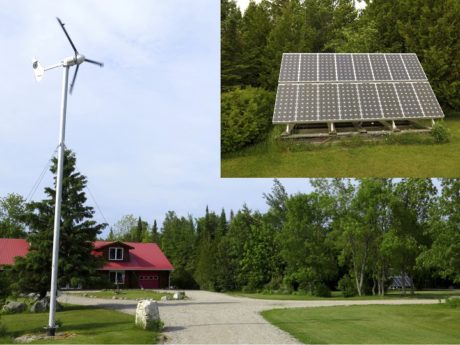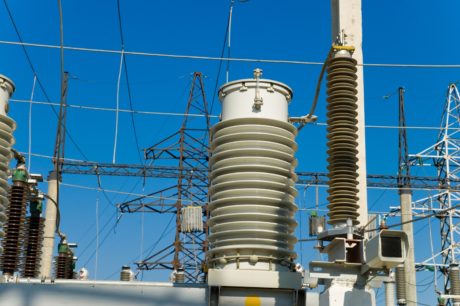Is it really possible to enjoy a modern lifestyle without being connected to the electrical grid? Yes, it is. Thousands of people do it, including a couple named Fritz and Anne Kettling. Back in 1997, they built their own off-grid electrical system to provide power for appliances, for controlling their heating system, for powering electronics, energizing their lighting and running power tools in their modern rural home and workshop. They live on a quiet corner of a quiet island that’s 10 miles from the nearest power lines. A grid connection would have cost $360,000 back then, plus they’d then have to pay for power forever. Naturally, they said “no thanks. We’ll do it differently.”
Since the Kettlings were absolutely committed to building their house on a particular piece of remote lakeshore property, they created an independent power system of their own that’s also pretty much completely immune to anything that happens in the wider world. I say “pretty much” because part of their system does include a stationary propane backup generator as a supplemental source of power for charging the bank of batteries if wind and solar generation can’t keep up. Their generator is larger than it needs to be for occasional recharging, but it’s sized to run the 380 volt, 3-phase industrial machinery Fritz has in his metalworking shop. That’s not a typical situation, but having fossil fuel backup isn’t a bad idea if you want 100% assurance you’ll have plenty of power all the time. That said, a backup generator is not necessary for off-grid living. The design and information you’ll find here are based in part on the Kettling’s experience, updated to include modern hardware and design options that have become available since they built.
The video tour up next shows the real-world renewable energy system the Kettlings built. It’ll give you an idea of what it’s like to build one for yourself. Be sure to watch this.
 Wind and Solar – The Perfect Partnership
Wind and Solar – The Perfect Partnership
Taken on its own, a wind turbine brings a lot of energy freedom and reliability to any independent power system. Add photovoltaic (PV) panels to the system and things get even better. Cloudy weather could very well bring wind. A calm day might be clear and sunny. A wind turbine can gather energy at night, when the sun isn’t shining and energy demands are low. Equipment exists to allow both a wind turbine and PV panels to be connected to the same bank of batteries for charging, as you’ll see.
Before I get started, I want to explain something important. Let’s say you’ve got a building or home where you can’t connect to the grid for electricity or don’t want to. Why not just get a really nice fuel-powered generator and be done with it? This is what some people do, so why bother with the complication of solar, wind and batteries? Three big reasons: cost, peace-and-quiet and long-term electrical production.
Having a back-up generator is a wonderful thing during power outages that last for hours, days or weeks, but generators aren’t great as a sole source of permanent off-grid power. Most generators are loud, they need a surprising amount of maintenance and they won’t protect you in a very long-term power outage. That’s because gasoline and diesel generators still need the support of the entire petrochemical industry to keep running. What good is your generator when local gas stations have run dry because shipments of fuel have stopped? Even if there is fuel in underground tanks below the pumps, what if your local stations don’t have electricity to run their pumps? And what happens when a very long term power failure disables refiners?
Then there’s the issue of cost per kilowatt-hour of power. If you figure out all the costs involved in running a fuel-powered generator – even a very efficient model – you’ll find you’re paying many times more than the going rate for grid electricity – sometimes 10x the rate. Saving money compared to generator power is one reason why a multi-source, independent, renewable electrical system that uses a combination of solar and wind is worth building for long-term freedom from the grid.
Understanding the EMP Threat
The letters “EMP” stand for electromagnetic pulse, and this poses one of the single biggest threats to the modern world. Sounds crazy, but it’s true. EMPs are overloads of airborne energy that can fry electronics and the electrical grid. They travel through the air and through power cables and can occur naturally from solar flares, or by people intent on destroying our way of life. EMPs have done major damage before, and terrorists weren’t even involved.
Back in 1859, a natural solar flare triggered an EMP event that was so powerful it fried telegraph equipment in use at the time. Dubbed the “Carrington Event” after the astronomer who observed the solar flare happening, National Geographic writer Richard Lovett says that a repeat of the Carrington Event today would devastate our world. Modern electronics, power transmission systems and communications are much more sensitive to EMP destruction than the big wires of the old telegraph systems, wires that actually caught fire because the overload was so great. Experts warn that it could take years for North America to rebuild it’s electrical system after a massive EMP event. All major replacement power transformers are made off shore and take years to deliver after an order. Also, our electrical grid requires a source of electricity in order to fire up the system after a complete shut down. How would all this happen if North America or Europe was completely without power?
By having your own independent electrical system you can keep refrigeration, running water, heating controls and communications going without grid power. Will an EMP disaster occur? No one knows for sure, but the situation seems ripe for one. We’re vulnerable. If you wait for the need, it’s too late to protect yourself.
Even though the Kettlings aren’t survivalists in any sense of the word, their system provides an excellent and field-tested pattern to follow when creating an off-grid power system no matter what your goals are. Their independent system can provide up to 10 kW of grid-free renewable electricity and it’s done this in all seasons without a breakdown for decades. The same photovoltaic panels, same windmill, same bank of batteries have been working perfectly since 1997. Taking their design as a starting point, and learning from the experiences of others, I’ll show you the main parts of an independent, grid-free, collapse-proof renewable power system. You don’t have to build as big as the Kettlings did, but their work is an excellent place to start learning.





-
Add a note